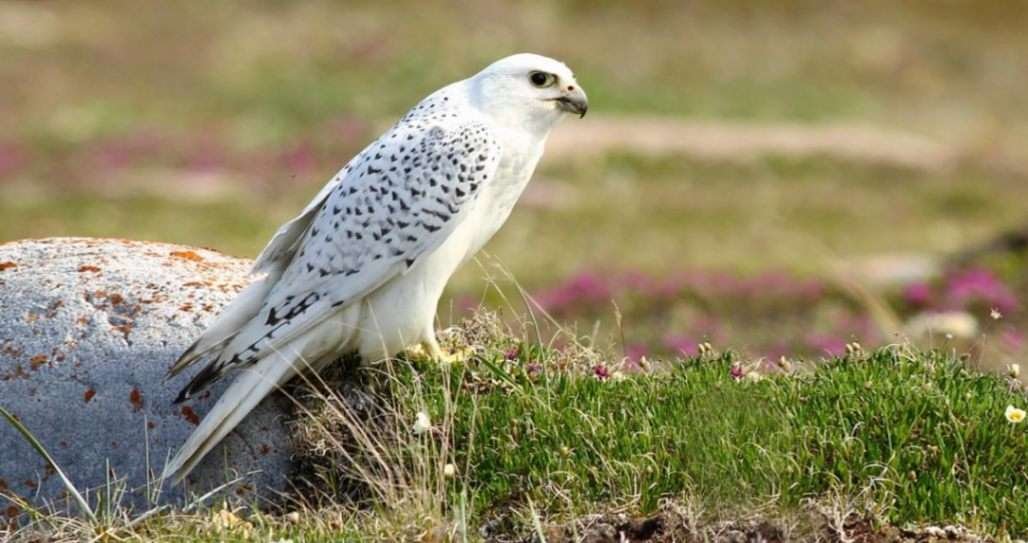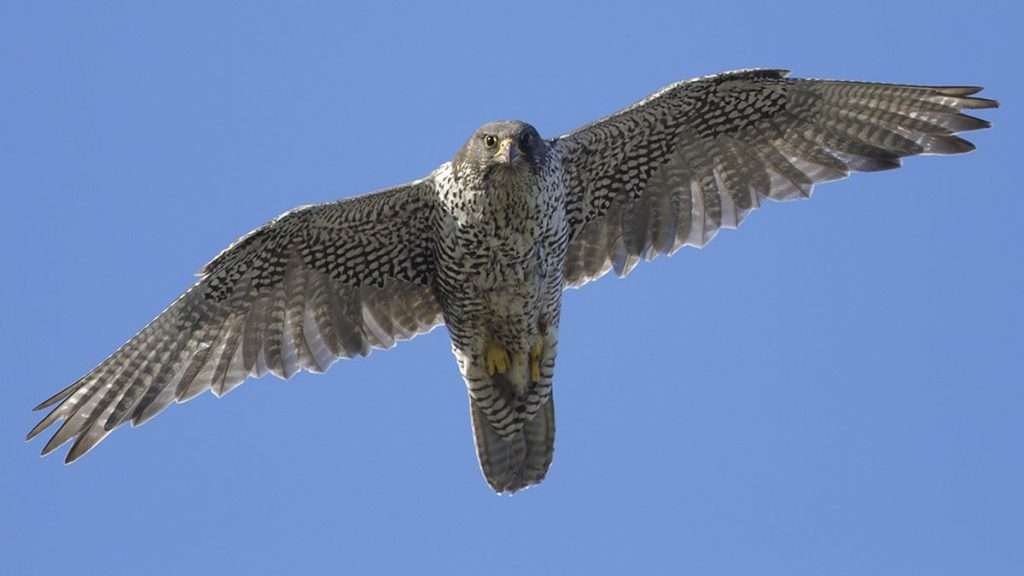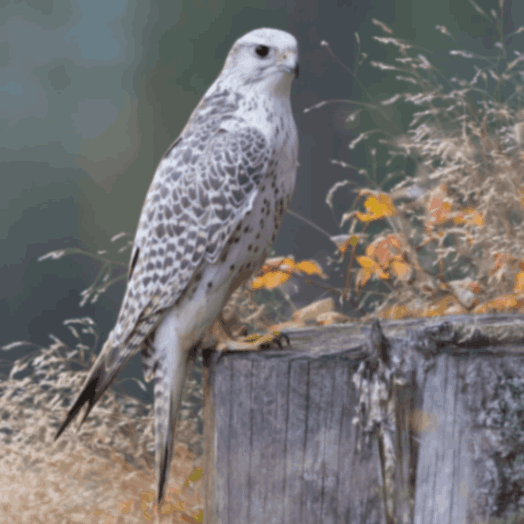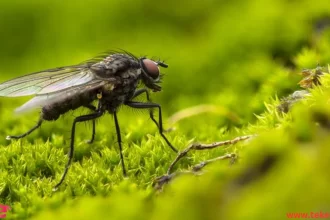In the far north, where vast expanses of land are blanketed in snow and fierce polar winds rage, emerges a stunning creature that defies the laws of survival and adaptation — the Gyrfalcon.
As the largest and most powerful falcon species in the world, the Gyrfalcon stands as one of the most highly adapted animals to extreme environments. Its allure goes beyond its majestic appearance and incredible speed, encompassing notable genetic diversity, evident intelligence, and complex behavior. Moreover, it shares a deeply rooted historical relationship with humans that spans centuries.
In this article from TekeTrek, we explore the multifaceted nature of the Gyrfalcon — from its genetic adaptability to various environments, to its intelligent behavior, vital ecological role, scientific tracking methods, and unique hunting tactics. We will also dive into the historical bond between humans and falconry involving this bird, concluding with legends associated with it and international laws aimed at protecting it from modern threats.

Habitats of the Gyrfalcon
- The Gyrfalcon lives in the Arctic and nests in North America on remote cliffs in extreme Canada and Alaska, where it is safe from most human disturbances but faces challenges due to rising climate temperatures.
- It is found in northern latitudes far from forests, and some individuals have been found nesting in trees, but most of them are in the Arctic tundra.
- The nesting habitat is usually among steep cliffs, while hunting and foraging areas are more diverse.
- Hunting areas may include coastal and beach areas heavily used by waterbirds, or descending from cliffs at unsuspecting prey such as small birds beneath them. It also includes the open tundra, where hunting ptarmigan and larger mammals is common.
- Habitat fragmentation does not currently pose a threat to this species, mainly due to the short growing season and the region’s climate.
- Winter may force the Gyrfalcon to move regionally to feed, while in southern climates, Gyrfalcons prefer agricultural fields reminiscent of their northern breeding areas, usually sitting low to the ground on fence posts.
Physical Characteristics of the Gyrfalcon
The Gyrfalcon is the largest falcon in the world, polymorphic, appearing in three colors: white, gray, and dark.
Dark gray Gyrfalcons are found in Canada, while white Gyrfalcons are found in Greenland.
The gray color of the Gyrfalcon is intermediate and found throughout the range.
With regards to Gyrfalcon size: Male Gyrfalcons weigh 800-1300 grams, with an average length of 53 cm, while females weigh 1400-2100 grams with an average length of 56 cm.
The Gyrfalcon has a distinctive shape similar to most falcons, including long pointed wings, a long tail, and a serrated beak.
Breeding Stages of the Gyrfalcon
- The Gyrfalcon nests in the remote northern parts of the world, and until recently, little was known about nesting sites, incubation times, maturation dates, or reproductive behavior.
- Although much has been discovered recently, many other aspects of the reproductive cycle have not yet been identified.
- Male Gyrfalcons begin defending the nesting area in mid-winter around the end of January, while females generally arrive at nesting sites near the beginning of March.
- Pair bonding occurs for about 6 weeks, after which eggs are usually laid near the end of April.
- Gyrfalcons do not build their nests in trees and usually find suitable nesting sites on cliff faces with a ledge and protrusion.
- Nest sites are used year after year, and prey remains accumulate in piles.
- The clutch can consist of 2-7 eggs, which are usually incubated by the female with some help from the male.
- The incubation period has recently been identified as 35 days, and all birds in the clutch hatch within a 24-36 hour period.
- Due to the cold climate, chicks are covered with heavy down and are left to thermoregulate themselves after only 10 days, when the female Gyrfalcon leaves the nest to join the male in hunting tasks for the growing family.
Behavior of the Gyrfalcon
- The Gyrfalcon is solitary except during the breeding season when it interacts with its mate.
- During non-breeding times, the Gyrfalcon hunts, feeds, and perches alone. It is generally non-migratory but moves short distances, especially during winter, to suitable areas where prey can be found.
- This falcon has no natural enemies due to its large size, but a variety of animals may prey on it if given the opportunity.
- Due to the Gyrfalcon’s large size and flying ability, many predatory animals cannot focus on hunting this species, and most deaths occur in inexperienced young birds or those that are injured.
Diet of the Gyrfalcon
- The Gyrfalcon is a predatory bird that feeds on certain types of birds and animals, especially ptarmigan, Arctic ground squirrels, and wild rabbits, as well as small mammals such as mice and some birds such as ducks, sparrows, and gulls.
- During hunting, the Gyrfalcon uses sharp vision to detect potential prey, as almost all animals in the north are vaguely colored to avoid detection.
- When potential prey is spotted, a chase usually occurs, ending with the prey being knocked to the ground with a powerful claw strike and then pounced upon.
- The Gyrfalcon has enough strength for continuous flight during hunting and sometimes consumes part of its prey to make catching it easier.
- During nesting, the Gyrfalcon also stores meals, which are usually large prey such as Arctic hares.


Genetic Diversity of Gyrfalcons: How Do They Adapt to Different Environments?
The Gyrfalcon is a living example of how organisms can genetically adapt to highly variable habitats. Its range stretches from the frigid Arctic tundra to rocky North American coastlines and the high mountains of Eurasia.
To survive in such diverse ecosystems, the Gyrfalcon relies on broad genetic diversity that allows for rapid adaptation. One of the most prominent examples of this diversity is the variation in feather color, ranging from pure white to gray and dark brown. This variation is believed to be a result of natural selection favoring individuals better camouflaged in their specific environment — white feathers blend with snowy backgrounds, while darker colors aid concealment among rocky coasts or mountainous terrain.
Genetic studies have also revealed diversity in genes related to temperature regulation and metabolism, giving the Gyrfalcon enhanced tolerance to climate variations, whether in freezing winters or brief warm seasons.
Gyrfalcon Intelligence: Cognitive Abilities and Complex Behavior
The Gyrfalcon is not only known for its immense speed but is also regarded as one of the most intelligent birds of prey. This intelligence is evident in its hunting behavior, learning ability, and social interactions.
Rather than relying on random attacks, it develops thoughtful hunting strategies tailored to changing situations. Ornithologists have recorded instances of young Gyrfalcons learning from their parents through observation and imitation — a rare trait among raptors.
Moreover, Gyrfalcons demonstrate high problem-solving skills during hunts, such as choosing alternative routes or using terrain to their advantage. In this regard, it can be compared to the Peregrine Falcon, the fastest bird on Earth, yet the Gyrfalcon surpasses it in mental flexibility and social cooperation, placing it at the forefront of avian cognition.
The Gyrfalcon’s Role in the Polar Ecosystem
In fragile ecosystems like the Arctic tundra, the Gyrfalcon plays a crucial role in maintaining the food chain. As a predator, it controls populations of rodents such as lemmings and seabirds like ducks and plovers.
This balance is vital — the absence of Gyrfalcons in a given area could lead to overpopulation of certain prey species, negatively impacting other animals and plants and disrupting the entire ecological cycle.
Areas inhabited by Gyrfalcons are often considered indicators of healthy polar ecosystems. Therefore, studying this bird helps scientists monitor environmental changes and assess the impacts of global warming in those regions.
How Are Gyrfalcons Tracked Scientifically?
Due to the difficulty of tracking Gyrfalcons in their natural habitat, especially during harsh winters, scientists employ advanced technologies, including:
- GPS trackers: These small, lightweight devices are attached to the bird’s back without affecting its flight and send periodic signals with its location and speed.
- Satellite telemetry: Enables researchers to monitor the birds’ movement across thousands of kilometers and continents.
- Genetic analysis of feathers and feces: Provides insight into genetic composition and diet.
- Nest cameras: Capture mating behavior and feeding of chicks in great detail.
These methods have led to detailed migration maps, revealing that some Gyrfalcons travel thousands of kilometers annually between breeding and hunting grounds.
Gyrfalcon Hunting: Between Instinct and Strategy
The Gyrfalcon is a masterful hunter, combining raw power with keen intelligence. Its hunting techniques vary depending on prey type and environment, showcasing advanced cognitive development. Among its primary tactics:
- High-speed vertical dives: Attacking from great heights with astonishing speed.
- Horizontal pursuits: Particularly effective along coastlines or over ice.
- Ambushes: Utilizing rocks and terrain curves to hide until the optimal moment.
Its hunting is never random — it involves split-second decisions and analysis of prey movement and obstacles, making the Gyrfalcon a truly unique predator among birds of prey.
Gyrfalcon and Falconry: A Historical Bond Between Bird and Human
The Gyrfalcon has played a prominent role in the art of falconry, long considered a royal symbol, particularly in Islamic and Central Asian cultures. Possessing a Gyrfalcon was once a sign of high social status.
Historical accounts tell of Abbasid caliphs and Mongol princes dedicating entire teams to train Gyrfalcons. In Kazakhstan and Mongolia, falconry using Gyrfalcons remains a cherished tradition passed down through generations, with the birds treated as companions rather than mere hunting tools.
Today, despite legal restrictions, the passion for Gyrfalcons thrives in the Arabian Gulf, where falconry tournaments are held and millions are invested in raising these majestic birds.
Gyrfalcon Protection Laws: What Does International Law Say?
Due to high demand, illegal capture of Gyrfalcons has led to population declines in certain areas. As a result, it has been listed under Appendix I of the CITES Convention, prohibiting international trade except under specific conditions and with official permits.
Collecting or destroying nests is banned in many countries. Global and national conservation programs are working to reintroduce Gyrfalcons into suitable habitats and release captive-bred birds into the wild — all part of broader efforts to protect biodiversity.
Legends and Folklore About the Gyrfalcon in Global Cultures
The Gyrfalcon has taken center stage in many folk legends. In Northern Europe, it was seen as a sky guardian and symbol of justice. In the Arabian Peninsula, it was associated with strength, honor, and bravery.
In Kazakh tales, it appeared as a companion to heroes across icy deserts. These stories immortalize the Gyrfalcon as a symbol of wisdom, courage, and spiritual connection to the skies, often depicted in poetry, songs, and ancient banners.
Frequently Asked Questions about the Gyrfalcon
- What is the meaning of Gyrfalcon, what are its characteristics?
The Gyrfalcon is one of the largest and most ferocious falcons, capable of flying long distances thanks to its wide wings.
- Where is the Gyrfalcon located?
It is located in the Arctic in America, Europe, and Asia, and during storms, some may lose their way to North America or Greenland.
- What are the colors of the Gyrfalcon?
The Gyrfalcon takes on many colors ranging from white and silver to pale white, and some species take on a black color.
- What is the diet of the Gyrfalcon?
It feeds on marine birds and various marine creatures, as well as reptiles and rodents such as mice, ground squirrels, or rabbits.
- How does the Gyrfalcon reproduce?
It prefers to live in nests close to the mountain cliff or high places and does not build its nests but uses abandoned nests or suitable places to lay eggs.
- What is the behavior of the Gyrfalcon?
The Gyrfalcon can communicate with other falcons of the same species and gather in groups for migration, using different sounds for communication or marking territory.
- How tall is the Gyrfalcon?
The gyrfalcon tall is between 20 – 25 inches.
- Are gyrfalcons aggressive?
The gyrfalcon’s aggressiveness is low.


In conclusion
In the end, the Gyrfalcon has not been recorded as endangered, and the numbers of these birds have remained relatively stable with few fluctuations over the long term. This may be due to the fact that habitat loss is not a major concern due to the low human presence in the north.





